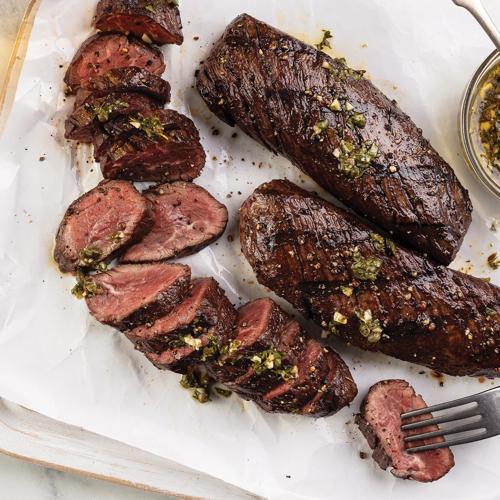
Butcher’s Guide: What is a Hanger Steak?
- by Omaha Steaks
- Jun 24, 2022
Hanger steak, sometimes called a “hanging tender steak” or “butcher’s steak,” boasts a notably thicker cut that’s packed with flavor and a uniquely coarse texture. So, what exactly is a hanger steak and how do you prepare it?
What is Hanger Steak?
There isn’t a lot of information online about this well-kept secret cut, and the information you can find often contradicts itself from one source to another. So, when it comes to learning more about the hanger steak, you need to go directly to the experts: Omaha Steaks master butchers. Much like flank and skirt steaks, hanger steaks are part of the “flat steaks” category of cuts. It derives its name from the location in which it is found, where it “hangs” from the diaphragm or upper belly, nestled between the plate and the loin. While it’s easy to understand why it’s called “hanger steak” based on where it’s located, why is it also known as “butcher’s steak?”
The answer to that lies in the fact that many butchers wouldn’t even offer it to customers and instead kept this cut a secret so they could take it home for themselves! With only one 1.5 lb. hanger steak available in each 800+ lb. animal, this cut is as rare as it is delicious. Considered by many butchers to be one of the tenderest cuts of meat, it features deep intramuscular fat, or marbling, that, once prepared, provides a rich flavor that’s undeniably juicy. Hanger steaks are versatile and can be enjoyed on their own or used as a delicious protein in steak fajitas and steak tacos, perfectly complemented with chimichurri sauce, and in a variety of other delicious recipes and dishes.
Cutting a Hanger Steak
The hanger steak is a primal cut that can be easily removed by separating it from the connective tissue and then trimmed of all tough gristle, for a tender, smooth bite. The remaining marbling is what makes it an especially tasteful cut of beef. Next, the thick tender that runs directly through the center of the steak is removed and the remaining beef is typically cut in half twice, resulting in four mouthwateringly tender steaks. Remember, because hanger steak comes from an area that serves a more supportive than active function, the meat isn’t overworked and firm, which you may find to be the case with skirt and flank steak cuts.

How to Cook a Hanger Steak
When prepared correctly, hanger steak will be supremely tender and full of the highly coveted rich flavor associated with other well-marbled cuts. While marinading the steak isn’t required, a good marinade will unlock even greater flavor and juiciness. If you’re searching for a tender bite with a nice crust, consider placing it over direct heat on a grill in a broiler 2 to 3 inches from high heat or on the stovetop in a smoking hot skillet. To avoid any bothersome smoke that may accumulate due to this steak’s inherent juiciness, use a high smoke point oil, like avocado oil, when cooking in a skillet.
Hanger steaks are at their most tender, juicy, and delicious when cooked to medium-rare doneness, especially as it continues to cook while resting. Use our Omaha Steaks mobile app with cooking timer to achieve your desired doneness. Check for doneness using a meat thermometer, these temperature guidelines, and our Steak Doneness Guide.
Rare 120-130° F
Medium rare 130-140° F
Medium 140-150° F
Well done 160-170° F
Let the steak rest for 5 to 10 minutes before serving.
How to Slice a Hanger Steak
As with any other steak, proper slicing can make a huge difference in flavor and tenderness. You should always cut against the grain when slicing a steak, and the grain of a hanger steak runs perpendicular to the length of the meat. That’s why it’s important to first cut the steak into short sections before turning them 90 degrees and cutting across the grain in thin strips. Cutting it this way ensures any chewy strong fibers are separated and you’re left with tender, juicy perfection.
More Butcher’s Guides:

Steaks for Everyone
Shop steaks by cut, texture, flavor — whatever you prefer! We’ve got something for everyone.

